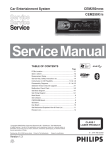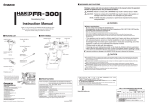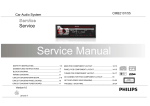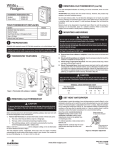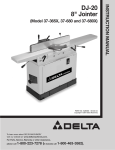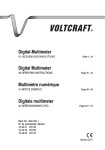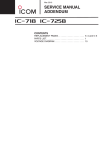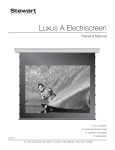Download NC620A Nixie Clock Kit Assembly and User Manual
Transcript
NC620A Nixie Clock Kit Assembly and User Manual Copyright (C) 2002 Cathode Corner. All rights reserved. Table of Contents Introduction............................................................................................................................................4 PC Board Assembly................................................................................................................................5 Installing in Your Own Cabinet ............................................................................................................13 Initial Checkout ....................................................................................................................................14 Operation..............................................................................................................................................16 Schematic Diagram...............................................................................................................................17 Panel Layout Diagram ..........................................................................................................................18 NC620A Clock Manual 7/25/10 3 Introduction The Clock The NC620A clock kit is a splittable PC board that provides power, timekeeping and drive to either four or six 13-pin Nixie tubes of the ZM1020, 6844A, NL8421 or B-5092 end-view type or the ZM1040 side-view type. It runs from 90-240VAC and uses an adjustable crystal oscillator as the timekeeping reference. Two pushbuttons (not included) are used to set the time. Jumper selection of 12 or 24 hour time display is provided. The clock may be built either as a four-digit clock or a six-digit clock. Four digit operation is obtained by cutting off the part of the PC board that holds the seconds display tubes. The clock may be built in the following three configurations: stacked, flat with components up or flat with components down. The user must supply a cabinet for this clock. The PC boards may be mounted either to the front or rear of the cabinet by means of six threaded standoffs provided. The Nixie tubes may protrude through the front of the cabinet, or they may be recessed. Colons built of a pair of neon lamps are provided to separate the time fields. Specifications Size End view, stacked: 8.8" wide x 1.8" tall x 2.9" deep including end-view tubes Side view, flat: 8.8" wide x 1.5" tall x 3.6" deep Power: 90 to 240VAC, 50-60 Hz, 2 watts Controls: Two SPST pushbuttons (not included) - red Set and black Advance Contacting Cathode Corner If you are having trouble assembling your clock, getting it to work, or you just want to talk with us about clocks, you may contact Cathode Corner in any of the following ways. Visit Cathode Corner on the Web at www.cathodecorner.com Phone: 520-795-7228 Email: [email protected] Mailing address: Cathode Corner 2602 E Helen Tucson AZ 85716 USA NC620A Clock Manual 7/25/10 4 PC Board Assembly Tools needed Soldering Iron, fine tip, 700 degrees F, adjustable temperature preferred Solder, 63/37 (60/40 is OK), .031" diameter or smaller, rosin or no-clean flux Small diagonal cutters Small long-nose pliers #2 Phillips screwdriver Decisions to make There are a few options to select when building the Nixie clock. These are: Stacked or flat form factor If flat, components up or down Four or six digits The board is provided as a single PC board that is scored down the middle. It may be left in one piece for a flat clock, or broken apart after assembly to make a stacked clock. It is recommended to keep the board in one piece during assembly. When building the board flat, the components may be up or down (relative to the tubes). Components up is best for a clock using side-view tubes that will e completely enclosed in a cabinet. Components down is best for a clock whose tubes will project up out of the cabinet. The display of seconds has the advantage of providing the mesmerizing motion of light as different elements of the seconds tube light up, causing the glow to move around in the tube. This shows off the charm of the antiquated display technique, and gives the viewer something to watch. On the other hand, a six-digit clock is bigger than a 4-digit clock, and the seconds display can be distracting. The seconds digit portion of the display may be cut off with a hacksaw along the dotted line if not wanted. This modification is NOT reversible! Nixie tube Selection The NC620A clock is designed to work with the older round end-view style tubes with the following numbers (or equivalent): 6844A, B5031, B5092, NL8421, ZM1020 If you purchased the clock with end-view tubes, then it will be supplied with New Old Stock ZM1020 tubes. If you purchased the clock with side-view tubes, then it will be supplied with ZM1040 tubes. The orange coating on the ZM1040 tubes may be removed, if you prefer the naked tube look. The contrast will be reduced, however. To remove the coating, soak the tubes in 120 degree F (50 C) water for a couple minutes. The coating will peel off easily. NC620A Clock Manual 7/25/10 5 Parts List The parts supplied in the kit are listed below in order of installation. 'Step' refers to the assembly sequence. 'Marking' refers to any part number printed on the part itself. PC Board parts Step Qty Marking 1 1 NC620A Description PCB, blank,NC620A designators 2 3 4 1 1 3 yel-vio-blk-gld yel-vio-yel-gld brn-blk-org-gld Res,47ohm,5%,1/4W Res,470K,5%,1/4W Res,10K,5%,1/4W R1 R8 R9,R22-23 5 6 org-org-org-gld Res,33K,5%,1/4W R2-7 6 7 6 10 red-red-red-gld red-red-yel-gld Res,2.2K,5%,1/4W Res,220K,5%,1/4W R10,R12,R14,R16,R18,R20 R11,R13,R15,R17,R19,R21,R24-27 8 20 resistor leads Jumper,0.2" long, U shape P11-12 to P21-22 9 10 11 12 2 1 2 1 1N4148 P6KE150 UF1006 DB105 Diode,1N4148,switching Diode,P6KE150,bipolar Diode,UF1006 Bridge,600V,1A,DIP D4-5 D2 D3,D6 D1 13 14 1 1 Socket,DIP,20pin Socket,DIP,16pin for U3 for U4 15 2 Socket strip,10pin P11-12 - install on solder side 16 2 gold pins Pin strip,10pin P21-22 - see text 17 18 19 20 1 2 1 1 white 22J 104M F1A250V Cap,Var,3-10pF,.2" Cap,Cer,22pF,50V,.1" Cap,Cer,0.1uF,50V,.1" Fuse,round,1Amp,250V C8 C9-10 C11 F1 21 22 23 6 6 1 ZTX458 ZTX558 LM2950 Transistor,NPN,400V Transistor,PNP,400V IC,LM2950-5.0,regulator Q1,Q3,Q5,Q7,Q9,Q11 Q2,Q4,Q6,Q8,Q10,Q12 U2 24 25 26 27 1 1 1 1 TO220 IC,TOP223Y,switcher Screw,6-32x3/8,panhead Nut,hex,6-32 lockwasher,#6,internal U1 for U1 for U1 for U1 NC620A Clock Manual 7/25/10 6 28 29 1 1 30 6 31 32 33 34 1 2 1 1 35 1 36 37 38 39 1 1 1 1 472K .1uF 10uF Cap,Cer,.0047uF,250VAC Cap,Poly,0.1UF,250VAC Cap,Elect,10uF,400V,.2" AC filter,26uH,10x13mm C4 C1 C2 L1 40 41 4 4 black Spacer,LED,0.6" Lamp,neon,short NE-2 for V7-10 V7-10 42 1 SC100T1A Transformer,power,custom T1 43 44 45 1 1 1 NC620Axx 74141 or 7441 black IC,CPU, programmed IC,DIP,74141,decoder Jumper,shorting, 2pin U3 U4 for E1 Description Screw,6-32x5/8,panhead Spacer,6x1/4,nylon Standoff,6-32x1.25,alum designators red 1uF 10uF 47uF 3.93 Header,2Pin,.100",Straight E1 Header,8Pin,.100",Straight P2 Socket,tube,13pin for V1-6 - see text Cap,Elect,1uF,450V,.15" Cap,Elect,10uF,25V,.1" Cap,Elect,47uF,25V,.1" Xtal,3.93216MHz,HC49 C7 C5-6 C3 Y1 Header,3Pin,.156",Straight P1 - remove center pin Final Assembly parts Step Qty Marking 46 6 47 6 48 6 49 50 1 1 Power cord,black,with pins Plug,3pin,.156" Molex for P1 51 52 53 2 2 1 Wires,red,24ga,w/pins Wires,black,24ga,w/pins Plug,8pin,.100" Molex for Set switch for Adv switch for P2 54 6 Tube,Nixie V1-6 depends Step by step guide The parts list has blank lines between groups of parts. These blank lines indicate when is a good time to solder all the parts that have been stuffed into the board. After soldering, cut the excess lead length from the component pins (except P1 whose pins are too stiff to cut). NC620A Clock Manual 7/25/10 7 PC board assembly Below are photos of the front and rear of an assembled board. Refer to these photos for guidance in parts placement. Top of NC620A PC Board (before separating) 1) The following procedure describes how to build a six-digit clock with seconds display. If you have chosen to use only four digits, then cut the PC board apart with a hacksaw at the dotted line between V4 and V5. Discard the portion with V5 and V6 on it. You will not install V7, V8, R24 or R25. Bottom of NC620A PC Board (before separating) 2-7) Install and solder the resistors first. Bend the legs of each resistor over at a 30 degree angle as it is installed, to keep it from falling out. This work goes faster if you install a batch of resistors, then solder all of them. The blank lines in the parts list indicate good times to solder. If you are building the board flat (not stacked), then save a couple dozen resistor leads for use as jumper wires to connect the two halves of the board at P11-22. NC620A Clock Manual 7/25/10 8 8) Perform this step only if you are building a flat clock. Do not do this if you will stack the boards. The two logic connectors P11 and P12 must be wired across to the display connectors P21 and P22 using jumper wires. To do this, make 20 jumper wires by bending resistor leads into a U shape with long-nose pliers. The middle part should be 0.2" long. It is possible to bend about 5 leads at the same time by putting them all in the pliers' jaws at once. Insert the jumper wires into the board so that each jumper connects a hole of P11-12 to its matching hole of P21-22 and bend over the legs at a 30 degree angle. Solder the jumper wires. 9-12) Install and solder the diodes next. Observe the polarity lines on the board. D2, the P6KE150, does not have a polarity mark. It may be installed in either direction. 13-14) Install and solder the sockets for U3 (20 pin) and U4 (16 pin). Double-check that the pin 1 end notch lines up with the notch shown in the PC board legend BEFORE soldering. 15) Perform this step only if building a stacked clock. Skip if building a flat clock. The two socket strips P11 and P12 will be soldered into the REAR of the PC board. Install these socket strips one at a time, using the following method. Install a socket strip into the solder side of the board at P11. Solder one end pin first, holding the socket strip in place with your finger on the middle of the strip so it doesn't get burned and making sure that the strip is not tilted. Solder the other end the same way. Now look at the board endwise and verify that the strip is not tilted. If it is, reheat the solder joints and adjust the angle. When you are satisfied that it is straight, solder the eight remaining pins. Repeat for P12. 16) Perform this step only if you are building a stacked clock. Skip if building a flat clock. The two pin strips P21 and P22 will be soldered into the PC board, with the pins protruding through the solder side of the board. Install these pin strips one at a time, using the following method. Insert the rounded end of the pins into the component side of the board so that the plastic support bar is on the component side. The pins should stick out the solder side of the board about 3/16" to 1/4". Solder one pin at each end of the strip first with a small amount of solder so that the solder does not cover the ends of the gold pin. Then reheat these solder joints one at a time while pushing gently on the strip to seat the plastic block squarely against the board. Finally, solder the other eight pins with a small amount of solder so that the solder does not cover the ends of the gold pins. 17-20) Install and solder the variable capacitor, the small ceramic capacitors and the fuse next. 21-23) Install and solder the transistors and U2 next. Be sure to orient these parts with the flat side as shown on the board silkscreen - the transistors have their marking in silver paint on the ROUND side. Push the transistor leads through the board so that about 1/4" of lead remains between the transistor body and the board. 24-27) Bend the legs on the TOP223Y towards the rear (flat) side of the part at the point where they become narrow, so that they will fit into the three small holes when the part is bolted in. Insert the 6-32 x 3/8" screw from the solder side of PC board, place the lockwasher and nut on the screw, and tighten snug. Solder the pins. 28-29) Install and solder E1 and P2. Be sure they are seated fully before soldering all pins. NC620A Clock Manual 7/25/10 9 30) Insert the six 13-pin Nixie tube sockets into the six Nixie tube locations as follows. If you are building the clock stacked or flat with components up, then the sockets go into the component side of the board (the side with the white silkscreen). If you are building the clock flat with bottom components, then the sockets go into the solder side of the board (the side without any white silkscreen markings). In either case, pin 1 is marked by the large square-outlined hole. The rotation of the sockets is as shown in the close-up photo below. Note that the missing pin is one position clockwise from the square pin when viewed with the socket up. Make sure each socket sits flush against the board, and trim any pin remnants that interfere with seating. Solder each socket at two opposite pins first. Press the socket against the board while reheating these two pins one at a time to be sure the socket is fully seated. Then solder the other pins. 31-34) Install and solder the small electrolytic capacitors and the crystal next. Observe capacitor polarity! Note that the Japanese manufacturers mark the negative lead of the electrolytic capacitors, but the PC board marks the positive hole with a + sign. The positive leads of the capacitors are longer. So put the long leads into the plus holes. 35) Pull out the center pin from the 3-pin header used for P1. This may be done with cutters used as a lever. Then install the header and solder. 36-39) Install and solder the large capacitors and the AC filter next. Observe the polarity marking on C2. 40-41) Install the four neon lamps (two if you cut off the seconds digits). Proceed as follows for each lamp: Cut 1/8" from one lamp lead to make the leads easier to thread into the spacer holes. Bend the leads so that they point slightly towards each other near the end. Slide the lamp leads into the open end of a black LED spacer so they poke through the holes at the other end. Insert the lamp plus spacer into the PC board. Bend over the ends of the leads and solder. Reheat the leads while pushing gently on the neon lamp to tightly seat the lamp stack against the board. Repeat for the other three lamps. 42) Install T1 next. First, solder its pins to the board. Cut off the two heavy gauge T1 wires, as they are not used. Twist the two light gauge wires together as a pair. Do NOT trim these leads to length, as they are delicate and difficult to strip. Wrap the pair of wires around T1 once to take up the extra length. Connect the two light gauge wires to the pads labeled W1. Be sure to put the right color wire in the right hole. Inspect the bottom of both PC boards for stray component leads that may be shorting together different pins. Also check for unsoldered pins. Clean off the flux if desired, using commercially available flux remover. (If you used no-clean flux solder, skip this step.) NC620A Clock Manual 7/25/10 10 43-44) Insert the proper CPU chip into the socket at U3. The types of CPU chips provided are: NC640A2T NC640A4T NC640A2B NC640A4B for ZM1020 End-view tubes, top mounted components or stacked for ZM1040 Side-view tubes, top mounted components or stacked for ZM1020 End-view tubes, bottom mounted components for ZM1040 Side-view tubes, bottom mounted components Bend the leads in slightly to make insertion easier. Align the notch end of the sockets with the notch end of the chips before inserting. 43-44) Insert the 74141 chip into the socket at U4. Bend the leads in slightly to make insertion easier. Align the notch end of the sockets with the notch end of the chips before inserting. 45) If you wish to display 24 hour time, install the black shorting jumper over the pins at E1. Board stack assembly If you have chosen to build the clock as a stack, you will need to break apart the boards and bolt them together. The procedure is described below. Below is a photo of the assembled clock showing the stacking of the boards, the arrangement of the spacers, and the installation of the Nixie tubes and neon colons. Photo of NC620A Clock PC Board Stack The logic board must now be stacked against the display board. Six 1/4" nylon spacers are provided for separating the two boards, and six aluminum standoffs are provided for mounting the assembled clock movement to the cabinet. Break apart the two boards by folding them towards each other along the score line, starting at one end. 46-48) Plug the two boards together so that all pins of P21 engage the socket P11 and all pins of P22 engage the socket P12. Hold a 1/4" nylon spacer between the two boards at one screw position using long-nose pliers. Put a 6-32x5/8" screw through the display board, the spacer, then the logic board. Screw a 1-1/4" aluminum standoff onto the screw. Repeat for the other five pairs of holes. NC620A Clock Manual 7/25/10 11 49-50) Route the power cord through the power cord hole in your cabinet (if you have a cabinet). Plug the two Molex pins on the power cord into the two end positions of the 3-pin plug shell. The center position is not used. 51-53) Plug the two red wires into the 8-pin plug shell as shown below. The red wires are the bottom wires in the photo. Plug the two black wires into the 8-pin plug shell as shown below. They are the two top wires in the photo. If you make a mistake, the wire can be removed by pushing on the small tab with a 1/8" slot screwdriver while gently pulling the wire out of the shell. Be sure to bend out the tang before reinserting the pin. Photo of switch connector Twist the two red wires as a pair. They will be connected to the Set pushbutton. Twist the black wires as a pair. They will be connected to the Advance pushbutton. 54) Install the Nixie tubes in their sockets by firmly pushing each until it is fully seated. The sockets are stiff before their first use, so some effort may be required. Don't worry - the tubes will not break from being pushed on with your thumb. The clock board is now ready to test. NC620A Clock Manual 7/25/10 12 Installing in Your Own Cabinet Selecting a Cabinet The Nixie clock requires a cabinet that will support the PC board stack, allow the digits and colons to be seen, protect the user from coming in contact with the high voltages present on the PC board, and provide for two control buttons for setting the time. Mounting the PC Board The PC board is mounted on the six standoffs provided. They may be left as is for mounting the rear of the assembly to the cabinet, or the standoffs and screws may be reversed in their holes to allow front mounting of the clock. The choice depends on the nature of the cabinet being used. A full-size, dimensioned drawing of the PC board is included at the end of this manual to aid in laying out your front panel. Power cord wiring Since the Nixie clock is a clock, a power switch is a hindrance rather than a help. The power cord is supplied with Molex pins crimped onto it. Feed the terminal end of the power cord into the power cord hole in your cabinet, pull enough cord through the hole to reach the PC board plus a couple inches for slack, and tie a knot in the cord for strain relief. Plug the two terminals into pins 1 and 3 of the female 3-pin Molex plug body. The cord is not polarized, so don't worry about which pin is which. Connecting Controls Header P2 connects to two pushbutton switches. The two red wires are for the Set button and the two black wires are for the Adv (advance) button. The Set button selects the time-setting mode and which digit is being set, and the Adv button advances the digit being set. Any type of SPST pushbutton switch may be used for these controls. Four wires with pre-crimped terminals are provided to simplify wiring of these controls. NC620A Clock Manual 7/25/10 13 Initial Checkout Plug the two Molex pins on the power cord into the two end positions of the 3-pin plug shell. The center position is not used. Plug the power cord into P1. Warning: DO NOT TOUCH ANY METAL PARTS ON THE PC BOARD WHILE POWER IS APPLIED! There are hazardous voltages present. Wait 10 seconds after unplugging power for the primary capacitor to discharge before touching parts on the PC board. Set the PC board, with tubes installed, on an insulated flat surface. Plug the power cord into an energized power outlet. The clock should begin displaying the time immediately as 00 00 00 (24 hour mode) or 1 00 00 (12 hour mode) with the seconds incrementing normally. The rightmost hours digit should be blinking. This blinking indicates that you need to set the time because the clock was just powered up. This is the power-failure indication. If the power supply makes a ticking noise, then there is an overload somewhere, probably resulting from a solder bridge or mis-installed part. If no ticking noise but no display, then there is likely a problem in the PC board soldering, or possibly a defective part. DO NOT connect test instruments to the power supply primary circuitry unless you use an isolation transformer, as the power supply primary is connected directly to the power line! If there is a problem, first inspect the board carefully for backwards components in the power supply areas, especially diodes. If this does not reveal the problem, look for solder bridges or component leads that are touching where they should not be. Test the fuse with an ohmmeter… if it has blown, then there is a short circuit or backwards part somewhere that needs to be corrected before replacing the fuse. If the display works but you see two different numbers appear at the same time in one or more tubes, then there is a short circuit between two cathodes. This can be caused by a solder bridge on U4 or one of the Nixie tube sockets or P11, P12, P21 or P22 If one tube fails to light, it may be defective. Check whether it is the tube or the socket by swapping the tube with another tube in the clock. If the problem follows the tube, then the tube is defective. If you obtained the tubes with your clock, contact Cathode Corner to obtain a replacement tube. If the problem is with the socket, check that socket's soldering and check its anode driver circuit for problems such as a bad or backwards transistor or the wrong resistor in the wrong place. Used Nixie tubes often exhibit a failure to function properly when first tested. The symptom is that one or more segments do not light, or do not light fully. This failure will usually correct itself within an hour or two of operation. If your used tubes do not function properly, just let the clock run a few hours, then swap the tube positions end for end, i.e. tens of hours with units seconds, units hours with tens of seconds, and tens of minutes with units minutes. Then let the clock run a few more hours. Any bad tubes will be evident at this time. However, some used tubes, especially the 6844A, suffer from excessive plated metal on the inside of the envelope resulting from exceeding the rated lifetime. This problem manifests itself by one or more digits not glowing, with the glow instead emanating from the leadin wires or behind the number plate stack. NC620A Clock Manual 7/25/10 14 This problem will not correct itself, so consider these tubes bad. Please don't sell them on Ebay as untested tubes! If all else fails… Cathode Corner wants satisfied customers. If your clock is not working and you cannot find the source of the trouble, you may mail the PC board (minus tubes) to Cathode Corner for repair. There is no charge for this service unless the PC board has been damaged due to improper assembly techniques. The mailing address is on page 2 of this manual. NC620A Clock Manual 7/25/10 15 Operation Selecting twelve or 24 hour time Twelve hour display of the time is standard for most people in America. Some people such as astronomers, shortwave listeners, and military folks prefer 24 hour time. Either mode may be selected my means of jumper E1. Install the small black jumper shunt block onto E1 if 24 hour time display is desired, otherwise leave it off. The jumper must be changed with the power cord unplugged, both for safety and for the CPU to read the jumper setting when the clock starts. Setting the time The Set button cycles the time-setting feature through the digits of the time, causing one digit at a time to blink. The Adv button advances the blinking digit through 0-9 or whatever is appropriate for that digit. To set the time, push the Set button once. The Hours digit will blink. Push the Adv button, and you will see the Hours digit advance through the sequence 1,2,3...11,12,1 etc. When the hours are set correctly, select the tens of minutes for setting by pushing the Set button again. The tens of minutes digit will now flash. Advance it with the Adv button till it is correct. Repeat for all digits. Regulating the time Unlike most wall clocks, this Nixie clock gets its operating frequency from a crystal oscillator. This is because a switching power supply does not provide an isolated, low-voltage source of AC line frequency, which is how most other electric clocks obtain their timing. Adjust the trimmer capacitor C8 to set the oscillator frequency. The slot has an arrow in it – when it points to the flat side of the capacitor, the oscillator is running fast, and pointing the other way is slow. In-between positions to either clockwise or counter-clockwise rotation have the same effect, since the capacitor is made of two half-circles of metal on rotating and stationary ceramic discs. Adjust the capacitor so that the arrow is pointing to the round end, which is the slowest setting. To remember which way is which, rotate the capacitor clockwise from this position about one quarter turn to set the speed faster. This is a good starting point. Now further clockwise rotation will speed up the clock and counter-clockwise will slow it down. Compare the clock to a known accurate source such as WWV, GPS or an official Internet time source (do NOT use your PC’s internal clock!). Wait a day or two then check for time gain or loss. Adjust the capacitor counter-clockwise if the clock gained time or clockwise if it lost time. Repeat as needed. Since crystal oscillators drift slightly with age, the clock regulation may need to be reset periodically. This may be done by adjusting the trimmer capacitor. NC620A Clock Manual 7/25/10 16


















